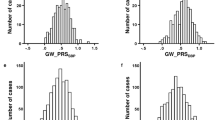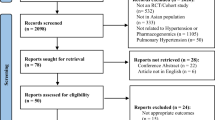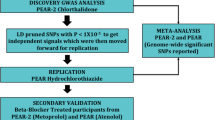Abstract
Nearly one-third of adults in the United States have hypertension, which is associated with increased cardiovascular disease (CVD) morbidity and mortality. The goal of antihypertensive pharmacogenetic research is to enhance understanding of drug response based on the interaction of individual genetic architecture and antihypertensive therapy to improve blood pressure control and ultimately prevent CVD outcomes. In the context of the Genetics of Hypertension Associated Treatment study and using a case-only design, we examined whether single-nucleotide polymorphisms in RYR3 interact with four classes of antihypertensive drugs, particularly the calcium channel blocker amlodipine versus other classes, to modify the risk of coronary heart disease (CHD; fatal CHD and non-fatal myocardial infarction combined) and heart failure (HF) in high-risk hypertensive individuals. RYR3 mediates the mobilization of stored Ca+2 in cardiac and skeletal muscle to initiate muscle contraction. There was suggestive evidence of pharmacogenetic effects on HF, the strongest of which was for rs877087, with the smallest P-value=0.0005 for the codominant model when comparing amlodipine versus all other treatments. There were no pharmacogenetic effects observed for CHD. The findings reported here for the case-only analysis of the antihypertensive pharmacogenetic effect of RYR3 among 3058 CHD cases and 1940 HF cases show that a hypertensive patient's genetic profile may help predict which medication(s) might better lower CVD risk.
This is a preview of subscription content, access via your institution
Access options
Subscribe to this journal
Receive 6 print issues and online access
$259.00 per year
only $43.17 per issue
Buy this article
- Purchase on Springer Link
- Instant access to full article PDF
Prices may be subject to local taxes which are calculated during checkout
Similar content being viewed by others
References
Keenan NL, Rosendorf KA . Prevalence of hypertension and controlled hypertension—United States, 2005-2008. MMWR Surveill Summ 2010; 60 (Suppl): 94–97.
Egan BM, Zhao Y, Axon RN . US trends in prevalence, awareness, treatment, and control of hypertension, 1988-2008. JAMA 2010; 303: 2043–2050.
Cartwright EJ, Oceandy D, Austin C, Neyses L . Ca2+ signalling in cardiovascular disease: the role of the plasma membrane calcium pumps. Sci China Life Sci 2011; 54: 691–698.
Kohler R, Brakemeier S, Kuhn M, Degenhardt C, Buhr H, Pries A et al. Expression of ryanodine receptor type 3 and TRP channels in endothelial cells: comparison of in situ and cultured human endothelial cells. Cardiovasc Res 2001; 51: 160–168.
Shrestha S, Irvin MR, Taylor KD, Wiener HW, Pajewski NM, Haritunians T et al. A genome-wide association study of carotid atherosclerosis in HIV-infected men. AIDS 2010; 24: 583–592.
Shibata MC, Leon H, Chatterley T, Dorgan M, Vandermeer B . Do calcium channel blockers increase the diagnosis of heart failure in patients with hypertension? Am J Cardiol 2010; 106: 228–235.
Yano M . Ryanodine receptor as a new therapeutic target of heart failure and lethal arrhythmia. Circ J 2008; 72: 509–514.
Yano M, Yamamoto T, Ikeda Y, Matsuzaki M . Mechanisms of Disease: ryanodine receptor defects in heart failure and fatal arrhythmia. Nat Clin Pract Cardiovasc Med 2006; 3: 43–52.
Davis BR, Cutler JA, Gordon DJ, Furberg CD, Wright Jr JT, Cushman WC et al. Rationale and design for the Antihypertensive and Lipid Lowering Treatment to Prevent Heart Attack Trial (ALLHAT). Am J Hypertens 1996; 9 (4 Pt 1): 342–360.
Arnett DK, Boerwinkle E, Davis BR, Eckfeldt J, Ford CE, Black H . Pharmacogenetic approaches to hypertension therapy: design and rationale for the Genetics of Hypertension Associated Treatment (GenHAT) study. Pharmacogenomics J 2002; 2: 309–317.
ALLHAT Collaborative Research Group. Major cardiovascular events in hypertensive patients randomized to doxazosin vs chlorthalidone: the antihypertensive and lipid-lowering treatment to prevent heart attack trial (ALLHAT). Jama 2000; 283: 1967–1975.
Siragy HM . Major outcomes in high-risk hypertensive patients randomized to angiotensin-converting enzyme inhibitor or calcium channel blocker vs diuretic: The Antihypertensive and Lipid-Lowering Treatment to Prevent Heart Attack Trial (ALLHAT). JAMA 2002; 288: 2981–2997.
Currie S, Elliott EB, Smith GL, Loughrey CM . Two candidates at the heart of dysfunction: The ryanodine receptor and calcium/calmodulin protein kinase II as potential targets for therapeutic intervention-An in vivo perspective. Pharmacol Ther 2011; 131: 204–220.
Thai TL, Arendshorst WJ . ADP-ribosyl cyclase and ryanodine receptors mediate endothelin ETA and ETB receptor-induced renal vasoconstriction in vivo. Am J Physiol Renal Physiol 2008; 295: F360–F368.
Thai TL, Fellner SK, Arendshorst WJ . ADP-ribosyl cyclase and ryanodine receptor activity contribute to basal renal vasomotor tone and agonist-induced renal vasoconstriction in vivo. Am J Physiol Renal Physiol 2007; 293: F1107–F1114.
Johnson AD, Handsaker RE, Pulit SL, Nizzari MM, O’Donnell CJ, de Bakker PI . SNAP: a web-based tool for identification and annotation of proxy SNPs using HapMap. Bioinformatics 2008; 24: 2938–2939.
Ikram MA, Seshadri S, Bis JC, Fornage M, DeStefano AL, Aulchenko YS et al. Genomewide association studies of stroke. N Engl J Med 2009; 360: 1718–1728.
Khoury MJ, Flanders WD . Nontraditional epidemiologic approaches in the analysis of gene-environment interaction: case-control studies with no controls!. Am J Epidemiol 1996; 144: 207–213.
Davis BR, Ford CE, Boerwinkle E, Arnett D, Eckfeldt J, Black H . Imputing gene-treatment interactions when the genotype distribution is unknown using case-only and putative placebo analyses--a new method for the Genetics of Hypertension Associated Treatment (GenHAT) study. Stat Med 2004; 23: 2413–2427.
Yang Q, Khoury MJ, Flanders WD . Sample size requirements in case-only designs to detect gene-environment interaction. Am J Epidemiol 1997; 146: 713–720.
Acknowledgements
This study was supported in part by grant HL63082 (GenHAT) from the NIH/NHLBI and grant N01-HC-35130 (ALLHAT) from the NIH/NHLBI.
Author information
Authors and Affiliations
Corresponding author
Ethics declarations
Competing interests
The authors declare no conflict of interest.
Rights and permissions
About this article
Cite this article
Lynch, A., Irvin, M., Boerwinkle, E. et al. RYR3 gene polymorphisms and cardiovascular disease outcomes in the context of antihypertensive treatment. Pharmacogenomics J 13, 330–334 (2013). https://doi.org/10.1038/tpj.2012.22
Received:
Revised:
Accepted:
Published:
Issue Date:
DOI: https://doi.org/10.1038/tpj.2012.22
Keywords
This article is cited by
-
Deep sequencing of RYR3 gene identifies rare and common variants associated with increased carotid intima-media thickness (cIMT) in HIV-infected individuals
Journal of Human Genetics (2015)
-
Integrated statistical and pathway approach to next-generation sequencing analysis: a family-based study of hypertension
BMC Proceedings (2014)



